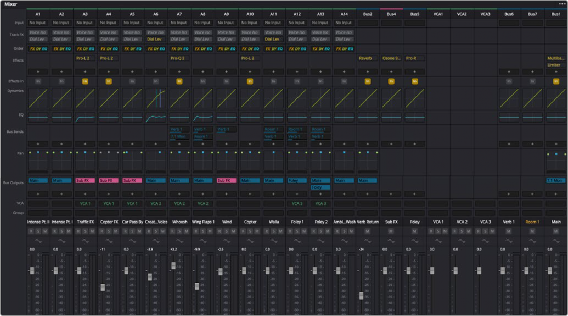
< Previous | Contents | Next >
This chapter describes the use of the Mixer to adjust the levels and fine-tune the audio of each track in the timeline. It’s focused on the function of the channel strip controls, with the following exceptions:
— For more information about bussing, see Chapter 167, “Setting Up Tracks, Busses, and Patching.”
— For more information about recording audio, see Chapter 169, “Recording.”
— For more information about mix automation, see Chapter 174, “Mix Automation.”
The Mixer
The Audio Mixer provides a set of graphical controls you can use to assign track channels to output channels, adjust EQ and dynamics, set levels and record automation, pan stereo and surround audio, mute and solo tracks, and add Fairlight FX, or VST, or AU effects plugins. At its most basic, each audio track in your timeline corresponds to an individual channel strip in the Mixer, and by default there’s a single main stereo mix bus labeled “Bus 1” that combines all these tracks into an overall mix.

The Audio Mixer with channel strips corresponding to the tracks in the Timeline
Tracks and Busses
Once you start creating busses, the Audio Mixer exposes two sets of channel strips. The leftmost set of channel strips correspond to the audio tracks in the Timeline, while the right-most set of channel strips expose sets of controls for each bus that you’ve created.
